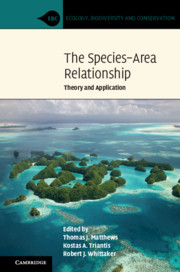Book contents
- The Species–Area Relationship
- Ecology, Biodiversity and Conservation
- The Species–Area Relationship
- Copyright page
- Contents
- Contributors
- Foreword
- Preface
- Part I Introduction and History
- Part II Diversity–Area Relationships: The Different Types and Underlying Factors
- Part III Theoretical Advances in Species–Area Relationship Research
- Part IV The Species–Area Relationship in Applied Ecology
- 13 The Identification of Biodiversity Hotspots Using the Species–Area Relationship
- 14 Using the Species–Area Relationship to Predict Extinctions Resulting from Habitat Loss
- 15 Using Network Analysis to Explore the Role of Dispersal in Producing and Maintaining Island Species–Area Relationships
- 16 Does Geometry Dominate Extinction due to Habitat Loss?
- 17 Using Relict Species–Area Relationships to Estimate the Conservation Value of Reservoir Islands to Improve Environmental Impact Assessments of Dams
- 18 An Investigation of Species–Area Relationships in Marine Systems at Large Spatial Scales
- Part V Future Directions in Species–Area Relationship Research
- Index
- References
16 - Does Geometry Dominate Extinction due to Habitat Loss?
from Part IV - The Species–Area Relationship in Applied Ecology
Published online by Cambridge University Press: 11 March 2021
- The Species–Area Relationship
- Ecology, Biodiversity and Conservation
- The Species–Area Relationship
- Copyright page
- Contents
- Contributors
- Foreword
- Preface
- Part I Introduction and History
- Part II Diversity–Area Relationships: The Different Types and Underlying Factors
- Part III Theoretical Advances in Species–Area Relationship Research
- Part IV The Species–Area Relationship in Applied Ecology
- 13 The Identification of Biodiversity Hotspots Using the Species–Area Relationship
- 14 Using the Species–Area Relationship to Predict Extinctions Resulting from Habitat Loss
- 15 Using Network Analysis to Explore the Role of Dispersal in Producing and Maintaining Island Species–Area Relationships
- 16 Does Geometry Dominate Extinction due to Habitat Loss?
- 17 Using Relict Species–Area Relationships to Estimate the Conservation Value of Reservoir Islands to Improve Environmental Impact Assessments of Dams
- 18 An Investigation of Species–Area Relationships in Marine Systems at Large Spatial Scales
- Part V Future Directions in Species–Area Relationship Research
- Index
- References
Summary
We simulate habitat loss and derive species accumulation curves (SAC) and endemics–area relationship curves (EAR) in order to predict expected extinctions. The EAR may have a very different shape depending on the geometry of habitat loss. If area is lost in a spatially random way we may preserve more species than if area is lost in a clustered way, but with a larger extinction debt. If area is lost continuously inwards (‘inward EAR’) then the immediate loss of species can be much greater than if the same area is lost from the core towards its edge (‘outward EAR’). The main reason for these effects is the spatial autocorrelation of species distributions and the definition of endemics. Spatial autocorrelation means that sampling plots that are clustered are occupied by communities with more similar composition. If endemism is defined in relation to the study area, we can observe great species losses at the edge due to the large numbers of ranges that intersect the study area edge, but most of these species persist outside the study area. If instead we examine endemism on a global scale then the pattern of species losses is not influenced by the geometry of habitat loss.
Keywords
- Type
- Chapter
- Information
- The Species–Area RelationshipTheory and Application, pp. 399 - 416Publisher: Cambridge University PressPrint publication year: 2021

